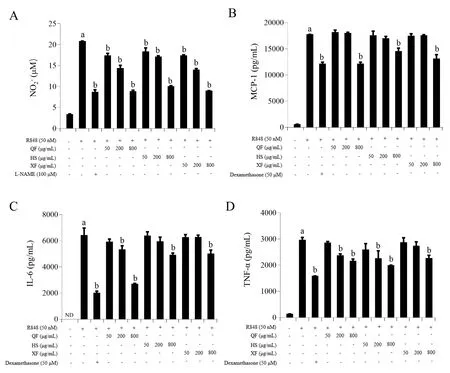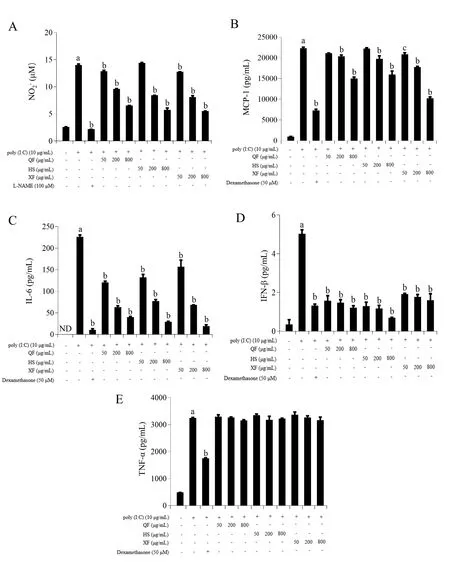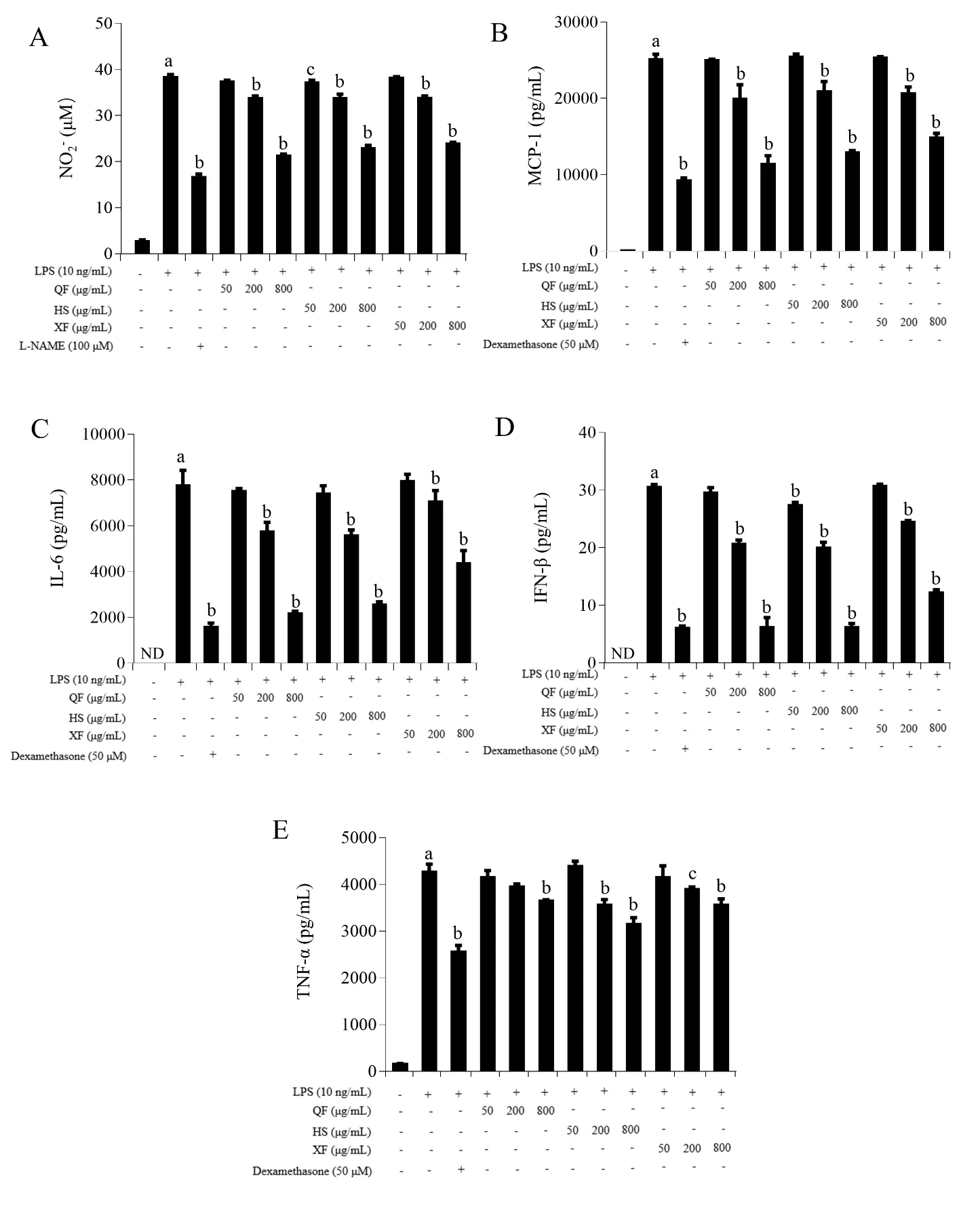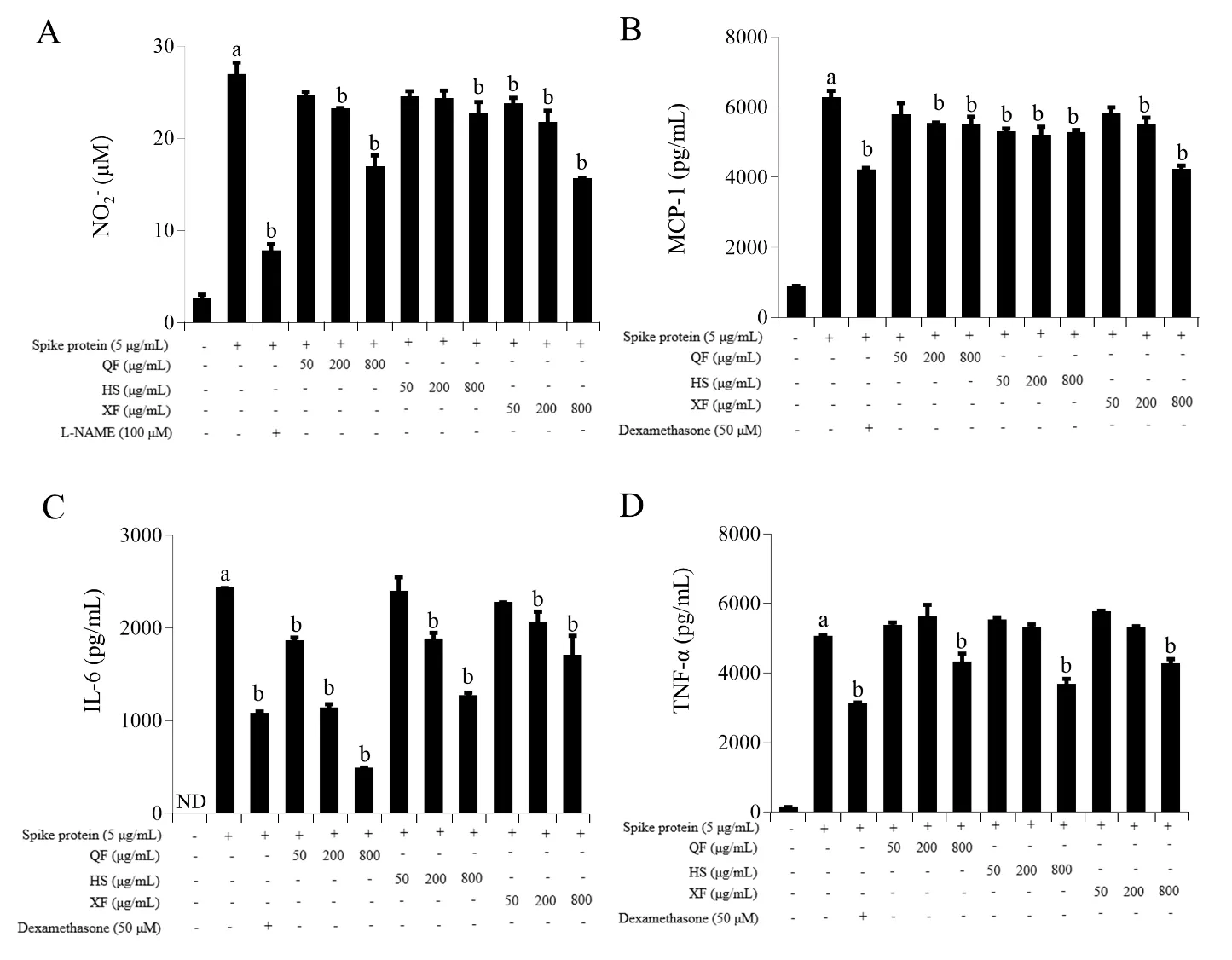Comparing the effects of three decoctions for coronavirus disease 2019 on severe acute respiratory syndrome coronavirus 2-related tolllike receptors-mediated inflammations
2023-02-15LIXimengKANGYuanLIWenjingLIUZhuangzhuangXUZhenluZHANGXiaoyuCAIRunlanGAOYuanQIYun
LI Ximeng,KANG Yuan,LI Wenjing,LIU Zhuangzhuang,XU Zhenlu,ZHANG Xiaoyu,CAI Runlan,GAO Yuan,QI Yun
LI Ximeng,KANG Yuan,LI Wenjing,LIU Zhuangzhuang,XU Zhenlu,ZHANG Xiaoyu,CAI Runlan,GAO Yuan,QI Yun,Department of Pharmacology and Toxicology,Institute of Medicinal Plant Development,Chinese Academy of Medical Sciences and Peking Union Medical College,Beijing 100193,China
Abstract OBJECTIVE: To compare the anti-inflammatory effects of three decoctions for coronavirus disease 2019 (COVID-19) [Qingfei Paidu Tang (清肺排毒汤),QF;Huashi Baidu Fang (化湿败毒方),HS;Xuanfei Baidu Fang (宣肺败毒方),XF] in parallelly experimental models by using severe acute respiratory syndrome coronavirus 2 (SARS-CoV-2)-related toll-like receptors (TLRs) ligands and its spike(S) protein as stimulators.METHODS: RAW264.7 macrophages were used to investigate the effects of three decoctions on the inflammations induced by R848,poly (I:C),lipopolysaccharide (LPS),as well as SARS-CoV-2 S protein,in vitro.Mouse endotoxemia model was used for evaluating their anti-inflammatory actions in vivo.The levels of monocyte chemoattractant protein-1 (MCP-1),interleukin-6 (IL-6),tumor necrosis factor α (TNF-α),and interferon-β (IFN-β) were determined by enzyme-linked immunosorbent assay.RESULTS:Three decoctions could decrease supernatant IL-6,MCP-1,nitric oxide (NO) and TNF-α to varying degrees in activated macrophages.Meanwhile,they did not increase the level of antiviral cytokine IFN-β induced by TLR3 and TLR4 ligands,but rather suppressed it,suggesting that externally administrated type I interferons (IFN-Is) may be needed for the severe COVID-19 cases characterized by deficient IFN-Is.In mouse endotoxemia model,all three decoctions could suppress serum pro-inflammatory cytokines,but only QF could relieve hypothermia and antagonize diarrhea.CONCLUSIONS: Collectively,our study compared,for the first time,the effects of three decoctions on SARSCoV-2-related TLRs-mediated inflammations.In vitro,three decoctions exert similar suppressive effects on inflammatory cytokines induced by SARS-CoV-2-related TLRs ligands,as well as S protein. In vivo,QF possesses the strongest effects compared with HS and XF.These findings may provide not only experimental basis for the clinical use of three decoctions,but also a rationale for the combination therapy with IFN-Is.
Keywords: COVID-19;toll-like receptors;inflammation;spike glycoprotein;coronavirus;Qingfei Paidu;Huashi Baidu;Xuanfei Baidu
Coronavirus disease 2019 (COVID-19) pandemic caused by severe acute respiratory syndrome coronavirus 2(SARS-CoV-2) continues to spread globally and results in a major public health and economic crisis.SARSCoV-2,a positive sense single-stranded RNA (ssRNA)virus,enters host epithelial cells by binding its surface glycoprotein spike (S) protein to the host receptor angiotensin-converting enzyme 2 (ACE2).1However,monocyte/macrophages may be infected with SARSCoV-2viaan antibody-mediated uptake route by Fcγ receptors.2,3After invasion,SARS-CoV-2 triggers the host’s innate immune response,thereby activating various immune cells (e.g.,macrophages) and eliciting the production of pro-inflammatory mediators.4Although the innate immune response is essential for host defense against invading pathogens,the hyperactivation of immune cells can also lead to cytokine storm which severely damages the body’s tissues and organs.Clinical reports indicate that strong infiltration of macrophages and cytokine storm are observed in bronchoalveolar lavage fluid of patients with severe COVID-19.5,6Therefore,controlling the cytokine storm may be an effective therapeutic strategy for COVID-19.Toll-like receptors (TLRs) on macrophages are important pattern recognition receptors (PRRs) that play key roles in innate immunity through recognizing the pathogen-associated molecular patterns (PAMPs).As an ssRNA virus,SARS-CoV-2 can be sensed by endosomal TLR7/8 and subsequently triggered the activation of myeloid differentiation factor 88 (MyD88)-dependent pathway.7Moreover,SARS-CoV-2 can also activate TLR3-TIR domain-containing adaptor inducing interferon-beta (TRIF) signaling,although TLR3 is typically served as the receptor for double-stranded RNA(dsRNA).8Surprisingly,S protein,the surface protein of SARS-CoV-2,can act as a PAMP by itself to activate membrane receptor TLR4.9,10The activation of these TLRs can lead to the production of inflammatory cytokines,including interleukin-6 (IL-6),tumor necrosis factor α (TNF-α),monocyte chemoattractant protein-1(MCP-1) and interferon-β (IFN-β).11Excessive activation of TLRs contributes to the cytokine storm which has been positively correlated with disease severity and death of COVID-19 patients.12,13
The decoctions of Qingfei Paidu Tang (清肺排毒汤,QF),Huashi Baidu Fang (化湿败毒方,HS) and Xuanfei Baidu Fang (宣肺败毒方,XF),collectively called “three decoctions”,have been used in China for treating COVID-19 patients.14They have shown remarkable effects on alleviating symptoms (e.g.,fever and cough),shortening disease duration,decreasing the time for nucleic acid conversion and preventing the progression of mild/moderate to severe diseases.15-18Although network pharmacology orin silicostudies compared the anti-inflammatory effects of three decoctions,the published experimental studies investigated only one or two of them by using only TLR4 ligand(lipopolysaccharide,LPS).19-23In the present study,we parallelly compared the effects of three decoctions on the inflammations induced by SARS-CoV-2-related TLRs ligands,as well as S protein.
2.MATERIALS AND METHODS
2.1.Reagents
Recombinant 2019-nCoV trimer S protein (C-6His)(Cat#DRA49) was obtained from Novoprotein Scientific Inc.(Suzhou,Jiangsu,China).R848,poly (I:C),LPS,N(omega)-nitro-L-arginine methyl ester (L-NAME) were from Sigma-Aldrich (St.Louis,MO,USA).Dexamethasone was acquired from Shanghai Yuanye Bio-Technology Co.,Ltd.(Shanghai,China).Nitric oxide (NO) assay kit was from Beyotime Institute of Biotechnology (Haimen,Jiangsu,China).Mouse TNF-α,IL-6,MCP-1 and IFN-β enzyme linked immunosorbent assay (ELISA) kits were from BioLegend,Inc.(San Diego,CA,USA).
2.2.Preparation of QF,HS and XF
Raw materials of three decoctions (Supplementary Tables 1-3)were from Anguo Chinese Medicinal Herbs Market (Baoding,Hebei,China) and authenticated by Prof.LIN Yulin (Institute of Medicinal Plant Development of Chinese Academy of Medical Sciences).The voucher specimens (QF-2020-1-21,HS-2020-1-14 and XF-2020-1-13) were deposited in our herbarium.The preparation processes for three decoctions were in accordance with clinical guidelines for Traditional Chinese Medicine decocting,and the raw materials were decocted three times.24The water extracts were filtered,mixed,and condensed by the rotary evaporator.The obtained solution was precipitated in ethanol-water(80:20,v/v) at 4 ℃ overnight and then filtered to remove precipitates.The filtrate was concentrated by the rotary evaporator and dried to constant weight.The yields of QF,HS and XF were 8.31%,11.81% and 6.05%,respectively.Previous studies had identified 498,217 and 42 compounds in QF,HS and XF by using 2D-LCQ-TOF/MS or UPLC-Q-TOF/MS method.21,25,26
2.3.Cell culture
The murine macrophage RAW264.7 cell line (ATCC,Rockville,MD,USA) was cultured in Dulbecco's modified Eagle’s medium containing 10% FBS in a humidified incubator with 5% CO2at 37 ℃.Cellular images were shown in Supplementary Figure 1.
2.4.Animal care and ethical statements
Male ICR mice [6-8 weeks,(24 ± 2) g,specific pathogen free] were obtained from Vital River Experimental Animal Services (Beijing,China) (license No.SYXK(Beijing) 2017-0020).All animal procedures were conducted in accordance with the ARRIVE guidelines and were approved by the Animals Ethics Committee of the Institute of Medicinal Plant Development.The mice were housed under specific pathogen-free conditions with a constant 12-h light/dark cycle with free access to a standard diet and water.The anesthetic drug (isoflurane)and other necessary efforts were used for reducing the animal suffering in studies.
2.5.Cell viability assay
Three decoctions were dissolved in culture media and sterilized by filtration using 0.2-μm syringe filters.Cell viability was detected by 3-(4,5)-dimethylthiahiazo (-zy1)-3,5-di-phenytetrazoliumromide assay as we previously described.27
2.6.Measurement of inflammatory mediators
RAW264.7 cells were pretreated with QF,HS and XF(50,200,or 800 μg/mL) for 1 h and then stimulated by SARS-CoV-2 S protein (5 μg/mL),R848 (50 nM),poly(I∶C) (10 μg/mL) or LPS (10 ng/mL) for another 24 h.Supernatant NO was indirectly reflected by measuring the nitrite level using Griess reagent,while the levels of MCP-1,IL-6,TNF-α,and IFN-β were measured by ELISA.L-NAME and dexamethasone were used as positive controls.
2.7.Mouse endotoxemia model
Clinical equivalent daily doses of three decoctions were used.ICR mice were randomly divided into 5 groups:normal control group,model group (1 mg/kg LPS),QF group (2.78 g/kg QF+1 mg/kg LPS),HS group(2.70 g/kg HS+1 mg/kg LPS) and XF group (2.40 g/kg XF+1 mg/kg LPS).In actual operation,daily doses of three decoctions were divided in duplicate.Mice were intragastrically administered with QF (1.39 g/kg),HS(1.35 g/kg) or XF (1.20 g/kg),while the mice in normal control and model groups received an equal volume of distilled water.One hour later,mice were intravenously injected with LPS,and the mice in normal control group were administered with an equal volume of normal saline.Immediately after LPS challenge,mice were intragastrically administered with QF,HS or XF,again.Two hours after LPS challenge,the rectal temperature was measured and the blood was collected.Serum TNFα,IL-6 and MCP-1 were measured by ELISA.The diarrhea symptom was also monitored for two hours after LPS challenge.
2.8.Statistical analysis
The areas of loose stools were calculated by Adobe Photoshop CC (version 2019,Adobe Systems Inc.,St.Jose,CA,USA).Data were presented as mean ± standard deviation () of at least three independent experiments and all statistical analyses were performed with the GraphPad Prism (version 7.0,GraphPad Software,San Diego,CA,USA).Differences between multiple groups were compared using one-way analysis of variance with the Tukey’s post hoc analysis while differences between only two groups were compared using an unpaired Student’st-test.P< 0.05 was considered statistically significant in all analyses.
3.RESULTS
3.1.Comparing the effects of three decoctions on TLR7/8-mediated inflammation in RAW264.7 cells
As an ssRNA virus,SARS-CoV-2 can be recognized by ssRNA-sensing endosomal TLR7/8.7Thus,a synthetic ligand of TLR7/8 R848 was used.28As a result,R848 (50 nM) induced dramatic increases of supernatant NO,MCP-1,IL-6 and TNF-α levels in RAW264.7 cells,while three decoctions could reduce these four pro-inflammatory mediators to different extents without cytotoxicity (Figure 1,Supplementary Figure 2).To be specific,their suppressive effects on supernatant NO were more prominent than the other three cytokines.Moreover,compared with HS and XF,QF exhibited stronger inhibitory effect on IL-6.
3.2. Comparing the effects of three decoctions on TLR3-mediated inflammation in RAW264.7 cells
Although SARS-CoV-2 is an ssRNA virus,it can also activate dsRNA receptor TLR3.8Therefore,a synthetic ligand of TLR3 poly (I:C) was used.29As shown in Figure 2,poly (I:C) (10 μg/mL) markedly increased the levels of supernatant inflammatory mediators in RAW264.7 cells,including NO,MCP-1,IL-6,TNF-α and IFN-β.Three decoctions exerted potently suppressive effects on IL-6 and IFN-β even at the minimum concentration (50 μg/mL),while they moderately decreased NO and MCP-1 levels.Notably,all three decoctions did not lower TNF-α level (Figure 2E).
3.3.Comparing the effects of three decoctions on TLR4-mediated inflammation in RAW264.7 cells
It was found that SARS-CoV-2 S protein alone,without the rest of the viral components,could act as a PAMP to activate TLR4.9,10Hence,a classical TLR4 agonist LPS was used.As shown in Figure 3,LPS (10 ng/mL)induced dramatic increases in supernatant NO,MCP-1,IL-6,IFN-β and TNF-α,while three decoctions significantly suppressed the secretions of NO,MCP-1,IL-6 and IFN-β in a concentration-dependent manner.However,all of them slightly decreased TNF-α (Figure 3E).
3.4.Comparing the effects of three decoctions on SARS-CoV-2 S protein-induced inflammation in RAW264.7 cells
As an unusual TLR4 ligand,S protein can initiate an unbalanced immune response,namely a weak production of IFN-β and a hypersecretion of pro-inflammatory cytokines.9,10Thus,we determined the effects of three decoctions on S protein-induced NO,MCP-1,IL-6 and TNF-α,without IFN-β,in RAW264.7 cells.As shown in Figure 4,5 μg/mL of S protein robustly elevated the levels of supernatant pro-inflammatory mediators,including NO,MCP-1,IL-6 and TNF-α,while three decoctions moderately decreased these mediators to different extents.Of note,QF possessed the most potently suppressive capacity on IL-6.

Figure 1 Effects of three decoctions on R848-induced inflammatory mediators in RAW264.7 cells

Figure 2 Effects of three decoctions on poly (I:C)-induced inflammatory mediators in RAW264.7 cells

Figure 3 Effects of three decoctions on LPS-induced inflammatory mediators in RAW264.7 cells

Figure 4 Effects of three decoctions on spike-protein-induced inflammatory mediators in RAW264.7 cells
3.5.Comparing the effects of three decoctions in endotoxemia mice
The abovein vitroresults revealed that three decoctions could suppress both TLR7/8-MyD88 and TLR3-TRIF signaling.Thus,we chose the mouse endotoxemia model,a classicalin vivomodel including both MyD88 and TRIF activation,to compare the effects of three decoctions.As a result,serum TNF-α,IL-6 and MCP-1 levels were markedly elevated by LPS (1 mg/kg).Three decoctions exerted obvious inhibitory effects on TNF-α while only QF significantly suppressed IL-6 and MCP-1(Table 1).Moreover,QF exerted the best inhibitory effects on LPS-caused hypothermia and diarrhea.30,31As shown in Table 1,LPS led to a marked decrease in rectal temperature (≈-1.4 ℃),while the mice of QF group had a 0.80 ℃ increase compared with that of model group (P< 0.01).Regarding LPS-induced diarrhea symptom,only QF significantly ameliorated diarrhea (P< 0.05),although HS also exerted a slight anti-diarrhea effect(Table 1).
Table 1 In vivo effects of three decoctions on the inflammatory responses in endotoxemia mice ()

Table 1 In vivo effects of three decoctions on the inflammatory responses in endotoxemia mice ()
Notes: normal control: vehicle;LPS: 1 mg/kg LPS;QF+LPS: 2.78 g/kg QF+1 mg/kg LPS;HS+LPS: 2.70 g/kg HS+1 mg/kg LPS;XF +LPS: 2.40 g/kg XF+1 mg/kg LPS.Mice were pretreated with QF,HS or XF for 1 h and followed by LPS challenge for 2 h.QF: Qingfei Paidu Tang;HS: Huashi Baidu Fang;XF: Xuanfei Baidu Fang;TNF-α: tumor necrosis factor α;IL-6: interleukin-6;MCP-1: monocyte chemoattractant protein-1;LPS: lipopolysaccharide;ND: not detected.aP < 0.01 versus normal control;bP < 0.01 and cP < 0.05 versus LPS alone.
4.DISCUSSION
Cytokine storm is an excessive immune response to external stimuli.The hallmark of COVID-19 pathogenesis is the cytokine storm with markedly elevated plasma levels of pro-inflammatory cytokines,as well as of several chemokines.32Therefore,the levels of cytokines have been used for predicting the severity of the disease and the mortality in these patients.33TLRs play essential roles in the activation of innate immunity through recognizing corresponding PAMPs upon SARSCoV-2 infection.34Three decoctions are officially recommended by the National Administration of Traditional Chinese Medicine for the treatment of COVID-19,especially for the patients in the early stage.15Through the comparative study,we found that three decoctions decreased supernatant IL-6,MCP-1,NO and TNF-α to varying degrees in RAW264.7 macrophages stimulated by TLRs (TLR3,4 and 7/8)ligands and SARS-CoV-2 S protein.Perhaps not coincidentally,all the three decoctions showed the most significant inhibitory effects on IL-6 whose elevation in blood was exactly one of the typical symptoms of COVID-19.35Type I IFNs (IFN-Is) family,including IFN-α and IFNβ,is one of the first lines of defense against viruses.It has been clinically used for treating corona virus infection for a long time.36,37For COVID-19 patients,IFN-Is have been proposed as the potential treatment,38which was also supported by the experimental evidence that SARS-CoV-2 was highly sensitive to IFN-Isin vitro.39QF was previously found to up-regulate the expressions of IFN-Is in THP1-Dual cells.40It is undoubtedly optimal if three decoctions combine the properties of suppressing TLRs-mediated inflammatory ℃responses and increasing IFN-β production,although this action mode is rare.In fact,our results showed that three decoctions potently suppressed the production of IFN-β induced by TLR3 or TLR4 ligand (Figure 2D,3D).This effect is consistent with that of their shared formula “Ma-Xing-Shi-Gan-Tang”(麻杏石甘汤).41From the aspect of innate immunity against virus,the effects of three decoctions are imperfect,especially for the severe COVID-19 characterized by impaired IFN-Is response.42Therefore,the combination therapy with IFN-Is may be more beneficial to overcome SARS-CoV-2 infection.43,44Thein vitroresults showed that three decoctions could suppress both TLR7/8/MyD88-and TLR3/TRIFmediated inflammatory reactions.Thus,we deliberately chose the ligand for TLR4 signaling (LPS),which contains MyD88 and TRIF pathways,as the stimulator to induce endotoxemia in mice.In contrast to HS and XF,QF not only significantly suppressed serum proinflammatory cytokines,but also relieved hypothermia and diarrhea (Table 1),showing the comprehensive actionsin vivo.Notably,its anti-diarrhea activity was remarkable.To understand the relationship between the anti-inflammation and anti-diarrhea actions of QF,an intestinal secretagogue castor oil (i.g.,25 mL/kg) was used.As a result,QF also markedly counteracted castor oil-induced noninflammatory diarrhea (Supplementary Figure 3),indicating that its anti-diarrhea activity is independent of its anti-inflammatory action.
In summary,our study compares,for the first time,the anti-inflammatory effects of three decoctions by using SARS-CoV-2-related TLRs ligands and S protein as the stimulators.The results demonstrate that three decoctions decrease the release of inflammation-related mediators,including IL-6,MCP-1,NO,TNF-α and IFNβ,to varying degrees in the activated-RAW264.7 macrophages.In contrast to HS and XF,QF possesses the strongest effects on endotoxemia mice,including suppressing serum pro-inflammatory cytokines,relieving hypothermia and antagonizing diarrhea.These findings may provide not only important insight into the anti-inflammation characteristics of three decoctions,but also a rationale for the combination therapy with IFN-Is.Future studies will be necessary to clarify the underlying mechanisms for the anti-inflammatory effect of each decoction.
猜你喜欢
杂志排行
Journal of Traditional Chinese Medicine的其它文章
- Potential of natural medicines for treatment of osteoporosis: a narrative review
- Outlook on cultural inheritance and development
- Upholding fundamental principles and breaking new ground: ensuring positive efficacy and reaching new consensus
- General principle of high-quality academic development of traditional chinese medicine: “carrying on the essence,while pursuing innovations”
- Effects of moderate-intensity aerobic exercise combined with acupuncture on attention function of mentally-retarded adolescents: a randomised controlled trial
- Reveal the mechanisms of prescriptions for liver cancer' treatment based on two illustrious senior TCM physicians
